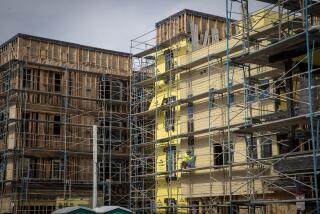Major Banks Raise Prime; Other Rates Likely to Climb
Most, but not all, major U.S. banks raised their prime lending rate Wednesday in response to slow but inexorable increases in inflation and the banks’ cost of money.
Economists generally agreed that this week’s increase in the prime rate indicates that interest rates have hit bottom and will begin a steady upward climb. Estimates of how far and how fast rates will move vary widely. But most economists expressed belief that rates charged to consumers for mortgages, personal loans and credit cards will inevitably begin to inch upward.
New York’s Citibank led the latest change in the prime on Tuesday, increasing the rate it uses to set borrowing charges for its customers to 7.75% from 7.5%. It was followed by many of the nation’s big banks, including California’s Security Pacific National Bank and Wells Fargo Bank, although the new rate has not yet been unanimously embraced.
Among the notable holdouts as of late Wednesday were Bank of America, Morgan Guaranty Trust and First Interstate.
The prime rate, which many banks refer to as their reference rate, last changed on Aug. 26, when it fell to 7.5% from 8%. It had been dropping steadily in half-percentage-point increments since mid-1984.
“This is no doubt the beginning of a general rise,” said Jerry L. Jordan, chief economist at Los Angeles’ First Interstate. “We had been expecting both short and long-term market rates to notch higher. With the usual lag, the prime will rise; later, with a longer lag, consumer and mortgage rates will follow. We think we’ve seen the low for the cycle.
“The economy is much stronger than most people were thinking, the dollar is crashing, inflation is about three percentage points higher this year than last--all these things contribute to stopping the fall of rates. We’ve seen the lowest inflation rate for the rest of the century. We’ve probably seen the lowest interest rates for the rest of this decade.”
While most other observers did not go quite that far, economists generally concur that inflation is running at about a 5% annual clip, compared to about 1.9% last year.
“We’re getting pretty clear-cut acceleration in the inflation rate. That’s one of the factors putting pressure on longer-term interest rates,” said Lacy Hunt, economist and money manager at the Philadelphia bond trading firm of Carroll, McEntee & McGinley. Hunt said inflation is rising faster than interest rates, meaning that real, inflation-adjusted interest rates are still falling.
Third World a Factor
The sharp fall of the dollar has been a major factor in the rise in short-term rates, several economists noted. A weak dollar reduces the returns on dollar-denominated assets for foreign investors, who then seek to offset the drop with higher rates from banks that borrow billions in the global money markets.
The major banks also face profit pressures from the Third World. Stuck with billions of dollars in outstanding loans to developing nations, the banks have been refinancing much of the credit at lower interest rates in the face of possible default by the debtors.
The major U.S. banks with large loans to Brazil will likely suffer substantial losses because of the suspension of interest payments that country declared Feb. 20. A small rise in the prime will help them recoup some of that lost income.
On Wednesday, BankAmerica and J. P. Morgan & Co. said they were declaring a large portion of their Brazilian loans non-performing and would adjust first-quarter earnings downward.
At the same time, the trade dispute between the United States and Japan has increased speculation that the dollar will fall further and Congress will enact protectionist legislation, both of which threaten to boost inflation and, in turn, interest rates.
Effect on Home Loans
For consumers, the prime rate increases will be felt most directly in home equity loans and credit cards with variable interest rates tied to the prime.
Fixed-rate and adjustable-rate home mortgages also are likely to move higher, but that reflects the broad movement of open market rates more than the prime, said Barry Havemann, president of HSH Associates, publisher of a national mortgage rate survey.
Economist David Levine of the New York investment house of Sanford C. Bernstein & Co. was more specific. “Fixed-rate mortgages are about 9% right now. I would expect them to be 11% to 11 1/2% by year end.”
Levine predicted that adjustable-rate mortgages would move up by a similar margin.
More to Read
Inside the business of entertainment
The Wide Shot brings you news, analysis and insights on everything from streaming wars to production — and what it all means for the future.
You may occasionally receive promotional content from the Los Angeles Times.










